New Technologies for Process Analytical and Quality Control Applications: Compact Raman
Guest author John Coates describes a new, compact handheld Raman instrument.

Greetings, seekers of new spectroscopic "toys." As is my wont, I try to discover new gadgets in the fields of molecular spectroscopy. Fortunately, I know — pretty much — who is working on things that fit my criteria for "great" (smaller, faster, and wireless). The last criterion can be substituted with "portable." Thus, I can pester these folks for articles for this space. This month, in time for PittCon, I have a sweet piece by my friend, John Coates (Coates Consulting, Newtown, CT) about a nifty, handheld Raman instrument. Eventually, I will present several of John's innovations, but this is the first he wished to share. Enjoy!
New Technology Sources
This is the first in a series of three articles I will contribute to this column that will discuss the emergence of new instrumentation technologies expected to impact the role of spectroscopy outside of the boundaries of the laboratory. In this article, a new concept for Raman spectroscopy will be reviewed as it pertains to process analytical technologies (PAT) and other industrial applications. While the technology crash at the start this decade did much damage to the economy of this country (and to our personal savings), it did spawn new concepts of measurement that are surfacing now. These are providing excellent opportunities for new spectroscopic applications.
The telecommunications industry is one of the industries that nosedived, but since has offered up new products and technologies. Four major attributes come from this telecom heritage — miniaturization, ruggedness, advanced optical concepts, and the potential for low-cost production. These attributes meet many of the needs for PAT, and represent an opportunity to change the way that instrumentation is viewed and implemented. This is a move away from the traditional instrument and towards the spectral sensor. Next stop . . . the fabled Star Trek Tricorder?
Raman Spectroscopy as a Process Analytical Tool
The period between 1967 and 1972 was a landmark time in modern spectroscopy. Within that window of time there were critical advances in vibrational spectroscopy, with FT-IR and "Laser Raman" spectroscopy at the top of the list. At that time, the two techniques were to take over from the status quo — or at least that was the belief. Eventually, in the 1980s, FT-IR did become the de facto standard for infrared spectroscopy. Raman spectroscopy promised to be a leading technique, offering unique opportunities for micro sampling, work in aqueous solutions, and simplified optics, based upon the use of glass, rather than the exotic materials required in mid-infrared spectroscopy (mid-IR). There is no doubt that Raman has found a strong place in today's analytical chemistry arsenal. Also, there are some significant and unique opportunities for the technique. But, until recently, it was difficult to view it within the context of modern day IR spectroscopy.
Mid-IR has become a cost-effective, pushbutton technique in the laboratory, being used for a wide range of applications. The desire has been to try to get Raman to be of equivalent status. The system covered in this article has the opportunity to fulfill this desire. It is a compact, easy-to-use device with push-button operation. Additional advantages over its infrared spectroscopy counterpart are that it is completely portable and does not require any special sample-handling accessories.
Today's Raman systems feature low-power near infrared (NIR) lasers, operating with a few hundred mW of power. The NIR wavelength of incident light reduces the occurrence of fluorescence and the lower power aids laser safety. The key to improved performance of modern instruments is, in part, due to improved photon management. The handheld analyzer covered in this article (Ahura Corp., Wilmington, MA) is an example of optimized light management, by providing a simple-to-use sample interface, with minimal issues relative to laser safety.
This instrument provides three pre-defined levels of laser power output: 50, 150, and 300 mW. Two simple approaches to sample handling are provided: one with sample cavity designed to accept glass sample vials, and the other in the form of a sample "proboscis" in which the laser is focused just beyond the tip of the "proboscis-style" probe. This instrument, currently marketed for hazmat and homeland security applications, is known as the Defender. To meet the needs of these applications, the analyzer has been designed to meet military specifications in terms of performance, reliability, and ruggedness.
The primary application (at this time) is for the characterization and identification of dangerous chemicals, usually in their containers, with a highly simplified user–operator interface. While these specifications clearly meet the needs of the original application, anyone familiar with plant-based operations will recognize that they also are ideal for a wide range of plant and manufacturing applications. The concept of a handheld instrument that can survive the 6-ft drop test and can provide detailed spectral analysis at the push of a button should be enough to make it popular with any plant manager or technician.
This Raman analyzer is completely self-contained, operating on battery power (small lithium ion rechargeable cell), and housed within a rugged and sealed enclosure. The unit is constructed with a stabilized 785-nm (NIR) solid-state laser source, an integrated imaging module, and a 2048-pixel diode-array-based spectrograph. All electronics, including a single-board processor, also are fully integrated. As noted, the user interface is a simple set of push-button controls linked to a menu-driven color liquid crystal display, as shown in Figure 1. A sophisticated chemometrics-based spectral search package is included that provides positive identification for discrete compounds and calculated compositions for materials identified as mixtures. The success of the identification is dependent upon the compound in question being in the stored database. If the material is identified as a mixture, then an attempt is made to identify the components, based upon their contributions to the Raman spectrum (from the pure component spectrum), and to indicate the percentage composition, as indicated in Figure 1.
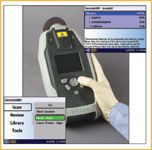
Figure 1. The Ahura handheld Raman system illustrated with the simple menu-driven user interface.
The system described originally was designed for a demanding and hazardous application. Meeting the requirements of this application ensures that the system is well-matched to demands of applications related to process analytical and product quality control. Raw material screening in warehouses and production areas is a broad-based application for many industries, from pharmaceuticals to consumer and food-based production. A major benefit of the technique is the ability to characterize materials within the original container, as illustrated in Figure 2.

Figure 2. Convenient sample handling for material identification with sample container.
It is not difficult to envisage a variety of plant-based applications for the analyzer in its current form, from this example of materials screening, to the at-line analysis of production samples, to the characterization of spills and residues found within a plant or factory environment. In this last example, an important application is for the screening of effluent and waste materials from all forms of manufacturing plants, including those which are not traditional candidates for process analytical chemistry, such as metals manufacturing and metal treatment plants. The current format of the analyzer is ideal for plant applications, insofar as the user interface is simple, and the packaging is rugged, and has the potential to meet the requirements for operation in hazardous (flammable) environments. The analyzer currently is undergoing tests to evaluate its suitability for operation in environments that are defined by the National Fire Protection Association (NFPA) standards. The analyzer is a low-voltage device, and with its compact design it is anticipated that the current package will meet Class 1, Division 1, or Division 2 safety requirements.
Benefits of Raman for QC and Process Monitoring Applications
During the past decade, we have seen an increase in the use of Raman spectroscopy for process analytical applications, including some lab-based QC applications. In the traditional sense, Raman spectroscopy offers a number of advantages over other forms of vibration spectroscopy for "real-world" process and QC applications. These include the ability to operate in a glass-based environment, in which the sample can be monitored through a container or reaction vessel wall or through glass piping. This can minimize sampling requirements, and in some cases can eliminate the need for emersion probes, the latter making the monitoring nonintrusive and also eliminating the risk of probe fouling. In the case of the Raman system in question, the imaging can be optimized to be just beyond the glass surface.
Another benefit of Raman is the ability to monitor water-based solutions. Water is a weak Raman scatterer and as a result, it has a relatively weak contribution to the spectrum of water-based solutions. This is contrary to the limitations imposed on IR and NIR measurements. Many compounded products used for pharmaceutical and consumer-based applications are water-based, or contain similar solvents to water, and so a Raman-based system is ideal for inspection or production monitoring applications with such media.
If we review the information content of the Raman spectrum, we find that it can be as informative as the mid-IR spectrum, especially for materials characterization. The following is very much a generalization, but it does serve to define Raman as a qualitative and quantitative tool for process analytical chemistry. Both mid-IR and Raman have highly detailed spectra with a high redundancy in information content. At first sight, the IR spectrum is dominated by vibrations from polar functional groups, and skeletal vibrations linked to C–H and C–C vibrations. Raman is similar, and the spectrum also contains information related to C–H and C–C vibrations, and in general is dominated strongly by skeletal vibrations. Vibrations from polar groups, such as the C=O carbonyl group, tend to be relatively weak in the Raman spectrum, whereas polarizable groups, such as S–S, C–S, and C=C, which generally are weak in the mid-IR, do provide strong Raman signatures.
Skeletal vibrations are very much dependent upon the structure of individual molecules and, as such, Raman spectra tend to be highly individualistic in nature, whereas vibrations from characteristic functional groups are more systematic in nature, and as such are easier to characterize. Characteristic functional group vibrations are very dominant in the IR spectrum. Thus, spectral interpretation, in terms of the identification of fundamental functional groups and molecular structures, is relatively easy from the IR spectrum. As a result, families of compounds are recognized readily from repetitive signatures in their IR spectra. While some first-principles interpretation is possible from the Raman spectrum, it does tend to be compound dependent, and the contributions from the molecular backbone are often the most dominant.
For normal condensed-phase compounds, many of the characteristic frequencies from functional groups are observed in both IR and Raman spectra. Differences arise in intensity and it is common that a vibration that is strong in the IR spectrum is weak in Raman and vice versa. A good example is provided in Figure 3 by comparison of the spectra of vegetable oils, recorded directly in glass vials from the handheld system. These materials contain both an ester carbonyl group and at least one free double bond, normally with a cis configuration. In the infrared, the carbonyl centered around 1745 cm-1 is the most dominant band, and often the strongest band in the spectrum.
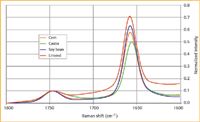
Figure 3. Comparison of the C=O (1745 cm-1) and C=C (1660â1650 cm-1) stretching vibrations for common vegetable oils.
As noted, the opposite situation occurs in the Raman spectrum, with the double-bond stretching vibration, located between 1660 and 1650 cm-1 , being one of the most intense bands in the spectrum. This is a very useful measurement because the characteristics and the functionality of these oils often are defined by the double-bond content (often measured chemically as an iodine value); the Raman spectrum provides a direct measure of these properties.
Essential oils are important as flavor and fragrance components. These compounds are differentiated in terms of chain branching and double bonds, as well as the presence of key function groups such as ketones, aldehydes, esters, ethers, and alcohols. It is very common to have multiple methyl groups on the same carbon atom with these compounds; Raman spectroscopy is a very sensitive tool for the detection of such structural arrangements. Figure 4 provides a comparison between α-pinene, a major component of pine oil, and eucalyptol (1,8-cineole), a component of eucalyptus oil. The latter is a component of common therapeutic ointment rubs. Both compounds have a gem-dimethyl arrangement with two methyl groups located on a single ring carbon atom. The intense band between 650 cm-1 and 600 cm-1 most likely is assigned to the symmetrical stretching of the methyl-carbon bonds for this grouping. Note that both spectra are uncorrected for detector response, and so the intensities of the higher frequency (wavenumber) bands are attenuated relative to their actual response. Both compounds provide rich spectra that are represented uniquely in the Raman, indicating further the ability of the portable Raman instrument to provide reliable material characterization.
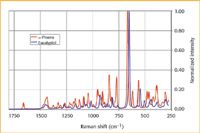
Figure 4. Characteristic skeletal vibrations for common essential oil ingredients.
The following are examples of solid-phase spectra, directly recorded from either the powdered or tableted forms of the materials concerned. In terms of unique characterization, the spectra of simple sugars (α-D-glucose, D-mannitol and D-sorbitol) and related compounds (ascorbic acid) are presented in Figure 5. The infrared spectra of these compounds are dominated by hydroxy (R–O–H) and (C–O–H), and ether (C–O–R) vibrations, and many such compounds appear very similar in the mid-IR. In the Raman spectrum, there is very little evidence of the hydroxy and ether vibrations, and the spectra are all different and highly differentiated as a function of their structures.
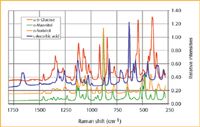
Figure 5. Raman spectra from powdered sugars and related compounds.
Many of these sugars are important in food and common pharmaceutical products, often used as excipients. Finally, while on the subject of formulated pharmaceutical products (dosage forms), the spectra of three common analgesics are presented in Figure 6. While they have been labeled as the active ingredient, there has been no attempt to separate them from any excipients. Such spectral data can represent the fully formulated products, and it is possible to quantify the ingredients, when the spectral data are available for the individual key ingredients. An example of such an analysis is provided on the display in Figure 1 for a compounded APC tablet. In this example, the concentrations were computed by calculating the contributions of the individual compounds to the overall recorded Raman spectrum.
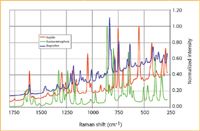
Figure 6. Raman spectra from common analgesic tablets.
Where We Are and Where We Can Go
This article has highlighted the operation and performance of a portable Raman system that originally was designed for a single purpose — for the identification and characterization of hazardous materials. In producing such an instrument platform, the manufacturer had to pay careful attention to key design criteria such as reliability, speed of operation, simplicity of operation, and reliability. While these are obvious key criteria for the application at hand — the identification of unknown toxic substances in spills or unmarked containers — they also are the criteria important for production and plant-based applications. With the current instrumentation focus on PAT, the portable Raman analyzer offers a host of application opportunities in the pharmaceutical industry, from raw material screening to the inspection of fully packaged dosage forms. In both cases, the analyzer can measure the material without special sample preparation, non-invasively, and if necessary, unwrapped in the original container or packaging.
Raman is a powerful technique for material identification and characterization. Although not addressed directly in the portable analyzer, it also can be used for quantitative measurements. Currently, the analyzer works stand-alone and spectral data are stored on a removable compact flash card. One can be certain that a means for wireless communication is not far behind. As indicated earlier, one more step towards the Tricorder.
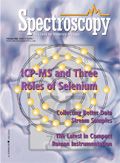
High-Speed Laser MS for Precise, Prep-Free Environmental Particle Tracking
April 21st 2025Scientists at Oak Ridge National Laboratory have demonstrated that a fast, laser-based mass spectrometry method—LA-ICP-TOF-MS—can accurately detect and identify airborne environmental particles, including toxic metal particles like ruthenium, without the need for complex sample preparation. The work offers a breakthrough in rapid, high-resolution analysis of environmental pollutants.
New Study Reveals Insights into Phenol’s Behavior in Ice
April 16th 2025A new study published in Spectrochimica Acta Part A by Dominik Heger and colleagues at Masaryk University reveals that phenol's photophysical properties change significantly when frozen, potentially enabling its breakdown by sunlight in icy environments.
AI-Driven Raman Spectroscopy Paves the Way for Precision Cancer Immunotherapy
April 15th 2025Researchers are using AI-enabled Raman spectroscopy to enhance the development, administration, and response prediction of cancer immunotherapies. This innovative, label-free method provides detailed insights into tumor-immune microenvironments, aiming to optimize personalized immunotherapy and other treatment strategies and improve patient outcomes.